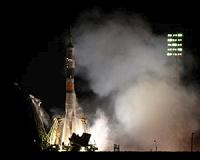 |
Washington DC (SPX) Oct 29, 2010 NASA has issued an announcement seeking proposals from U. S. industry to further advance commercial crew space transportation concepts and mature the design and development of system elements, such as launch vehicles and spacecraft. Awards will result in funded Space Act Agreements. Multiple awards are expected to be announced by March 2011 for terms of up to 14 months. Approximately $200 million total is expected to be available for awards under this announcement, but funding is dependent on the 2011 fiscal year appropriations from Congress. The deadline for submitting proposals is Dec. 13. The agreements are expected to generate significant progress toward maturing the design and development of commercial crew systems elements that also ensure crew and passenger safety. The overall objective is to accelerate the availability of U.S. commercial crew transportation capabilities and reduce the gap in U.S. human spaceflight capability. Through this activity, NASA also may be able to spur economic growth as potential new space markets are created. Once developed, crew transportation capabilities could become available to commercial and government customers.
earlier related report The Sabatier system can create up to 530 gallons of water per year from byproducts of the station's Oxygen Generation System and Carbon Dioxide Removal Assembly. The process is named for Paul Sabatier, a 1912 Nobel Prize winner in chemistry. "This is an important step forward in NASA's commercialization endeavors and shows how successful private industry can be at providing solutions on its own," said Bill Gerstenmaier, NASA associate administrator for Space Operations at the agency's Headquarters in Washington. "The ability to produce this water will be important for sustaining space station operations once the shuttle is retired." The system was integrated into the space station's Water Recovery System during the week of Oct. 11. Activation, checkout and first use of the system were completed Oct. 22, running for over eight hours. The Sabatier process uses a nickel catalyst to interact with hydrogen and carbon dioxide at elevated temperatures and pressures to produce water and methane. The water is retained for recycling processes, and the methane is vented outside of the space station. Prior to adding the Sabatier system, hydrogen produced while generating station oxygen was considered waste gas and vented overboard. Carbon dioxide generated by crew metabolism also was vented overboard. With the Sabatier system, these two former waste gases will generate a valuable product for the space station: water. Under contract to NASA, Hamilton Sundstrand supplied the flight hardware and operational support for a Sabatier-reaction-based system that operates as part of the station's Environmental Control and Life Support System. This contract is unique because NASA did not participate in design reviews or impose any specifications on the design, except for those defined in the safety, interface and acceptance requirements met by Hamilton Sundstrand. The company developed, procured, and built the flight hardware and support equipment needed for operations and training. The in-orbit operational portion of the contract runs until Sept. 30, 2014.
Share This Article With Planet Earth
Related Links Procurement at JSC Station at NASA Station and More at Roscosmos S.P. Korolev RSC Energia Watch NASA TV via Space.TV Space Station News at Space-Travel.Com
 Russia Sends New Space Freighter To Orbital Station
Russia Sends New Space Freighter To Orbital StationMoscow (RIA Novosti) Oct 28, 2010 A Russian space freighter has separated from its launch vehicle and is heading to the International Space Station (ISS) on a resupply mission, a Russian space official said Wednesday. Russia launched a Soyuz carrier rocket with the Progress M-08M cargo spacecraft at 7:11 p.m. Moscow time (15:11 GMT) on Wednesday from the Baikonur Space Center in Kazakhstan. "The freighter has separat ... read more |
|
| The content herein, unless otherwise known to be public domain, are Copyright 1995-2010 - SpaceDaily. AFP and UPI Wire Stories are copyright Agence France-Presse and United Press International. ESA Portal Reports are copyright European Space Agency. All NASA sourced material is public domain. Additional copyrights may apply in whole or part to other bona fide parties. Advertising does not imply endorsement,agreement or approval of any opinions, statements or information provided by SpaceDaily on any Web page published or hosted by SpaceDaily. Privacy Statement |